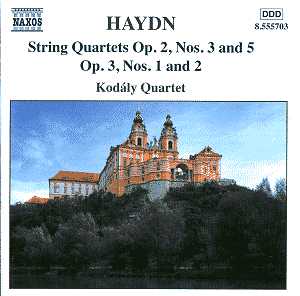On the march toward completing their traversal of Haydnís
String Quartets, the members of the Kodaly Quartet are now delving into
works of questionable authorship. The groupís previous disc contains
the last four quartets of Opus 3, which have been attributed to Pater
Romanus Hoffstetter (1742-1815). This new disc has the first two quartets
of Opus 3 along with string quartet arrangements of two Haydn Cassations.
Although he probably did not make the arrangements
of the two Cassations, the two works on the disc display the typical
signs of a Haydn composition: invigorating and exciting outer movements,
a fine division of legato and sharply etched phrasing, rhythmically
active and gritty minuets, lovely and calming slow movements, ample
variety of architecture, and sparkling atmosphere. I can assure readers
that the arrangements are fully idiomatic of Haydnís soundworld and
early chamber works.
The two String Quartets are fine works, but they are
not as inspired or structurally inventive as the Cassations. The phrasing
in the string quartets displays greater legato and rounded contours
with a sugary effect not common in Haydnís music. The repetition is
more extensive and less varied as well. I donít consider the two works
to be by Haydn, but equally there is no authoritative evidence to indicate
that Hoffstetter is the actual composer. Regardless of authorship, the
music is rewarding and in keeping with the generally cheery mood of
the Cassations.
The performances by the Kodaly Quartet are splendid.
They capture all of Haydnís most endearing musical traits and with perfect
form as well. The group fares better in these earlier Haydn works than
those from his full maturity. The present disc finds the ensemble at
its best, and I doubt that the music could be played any better. The
recorded sound is exceptional for its crispness and detail, and the
low level of richness befits the programmed works.
Early Haydn music is superior to the mature works of
all other Classical period composers with the exception of Mozart. The
arrangements of the Cassations are definitely as fine as any other works
from Haydnís young adulthood. The works attributed to Hoffstetter arenít
quite as rewarding, but even they are many steps ahead of the typical
fare of the period. Those who have been collecting the Kodaly series
will certainly want to add this latest installment to their record library.
For all others, just consider the disc a delightful and invigorating
diversion from the rigors of life.
Don Satz
